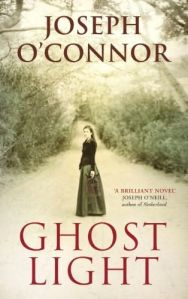Fiction – hardcover; Harvill Secker; 256 pages; 2010.
I’m not one for making predictions or backing horses, but if Joseph O’Connor’s Ghost Light doesn’t make the longlist for this year’s Booker Prize, I’ll eat my hat.
This is an accomplished novel that should firmly cement O’Connor in the canon of contemporary Irish literary fiction. Of course, he’s already achieved extraordinary success with Star of the Sea and its follow-up Redemption Falls, but Ghost Light, released earlier this month, feels as if he’s “arrived” in the sense that he can now take his rightful place alongside the likes of fellow countrymen Colm Toibin, John Banville, Sebastian Barry and the late (great) John McGahern.
Ghost Light charts the rise and fall of real-life Irish Catholic actress Maire O’Neill (1885-1952), who performed under the stage name Molly Allgood. She was engaged to playwright John Millington Synge, a Protestant 14 years her senior, at the time of his death to Hodgkin’s disease in 1909. Their relationship was frowned upon by pretty much everyone, including their families and Synge’s great friend William Butler Yeats, with whom he co-founded Dublin’s Abbey Theatre.
O’Connor takes pains in his “Acknowledgements and Caveat” to point out that while his novel features characters from real life, the story is a work of fiction. “The experiences and personalities of Molly and Synge differed from those of my characters in unaccountable ways,” he writes. “Most of the events in this book never happened at all. Certain biographers will want to beat me with a turf-shovel.”
Does it really matter that O’Connor has taken liberties with the truth? I think not. He has crafted an amazing story, from basic facts, and given life to a woman that history has sadly neglected.
We first meet Molly in London in 1952, where she resides in a lodging house, and as she makes her way across town towards an afternoon appointment at a BBC recording studio, we learn about her previous life in Dublin in 1908 when she was the star of the Abbey Theatre.
By jumping backwards and forwards in time in tune with Molly’s memory, we discover how she met Synge, became his lover and spent much of their relationship waiting for him to commit himself to her (it’s no spoiler to say he merely kept her hanging on for what appears to be no good reason) and we come to realise the direness of her present circumstances, so close to destitution that she is prepared to sell her most precious possession — a love letter from Synge — in exchange for a bottle of booze.
What I loved most about this book is Molly’s inner voice, which swings between pity and self-loathing, to a terribly wicked potty-mouthed sense of humour ripe with Dublin vernacular. Take this interior monologue as she looks at paintings in the National Portrait Gallery:
Heavens to Betsy, what an ugly old trout. Face like a bag of rusted spanners. Imagine, someone paid good money for that glower to be painted. More beauty in the door of a jakes, that’s the God’s honest truth. My Jesus Almighty, but there’s hope for us all, Molls. ‘The Duchess of Blandford’. Looks like Mussolini in a wig. Il Duce with udders. God help us.
But it’s her desperation, her poverty and her dependence on alcohol that make her story such an incredibly moving one. (In an exchange on Twitter, O’Connor’s agent, Carole Blake, told me that “Joe says he fell in love with her”.)
I came to the end of this book feeling as if I knew Molly personally, that I had witnessed her pain and her shame, her glorious success and her confusion at being passed over by lovers and theatre-goers alike. I wanted to put the book down and have a good old howl. And almost 10 days after finishing the novel I have spent my days thinking about Molly and her tragic life, always a good sign that I’ve read something meaningful and brilliant.
Finally, I’d like to add a caveat of my own: the story is told in the second person, which can take some getting used to, and O’Connor experiments with the novel’s form by including an entire chapter written as if it’s an act in a Synge play (which, in my view, is quite hilarious, seeing as it is a bit of a piss-take on Synge’s own tendency toward “Oirishness”).
But the book is so bursting with character that I think even those readers who favour traditional, straightforward narratives will find Ghost Light an entertaining and accessible read. Let’s just hope this year’s Booker judges feel the same way.

